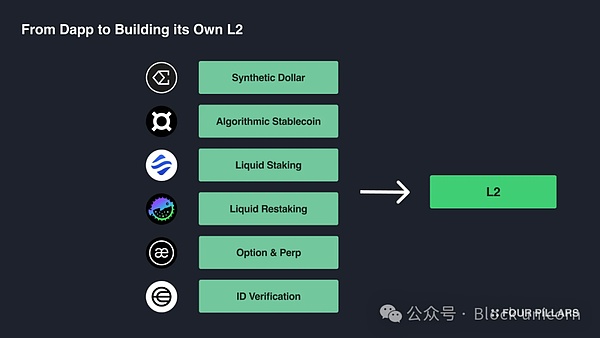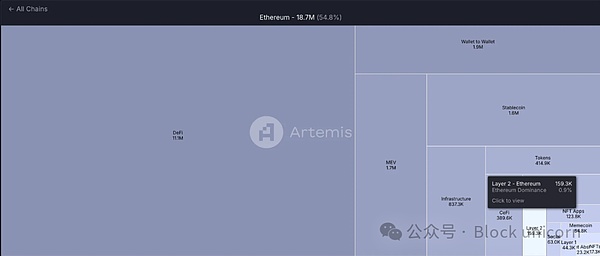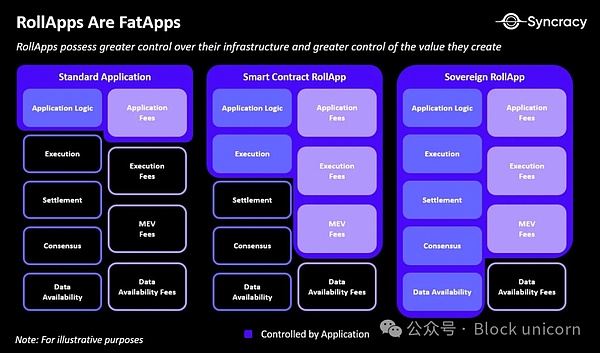Article author: Heechang, Dan Elitzer
In 2022, Dan Elitzer wrote (Dan is the founder of IDEO Futures and an old OG in the industry) that Unichain (the L2 chain launched by Uniswap) is inevitable, which he believes will stem from inefficiencies and value loss in the existing Uniswap system.He pointed out thatcurrentlyUniswap traders face three costs: exchange fees paid to liquidity providers, transaction fees paid to Ethereum validators, and MEV (miner extractable value) costs.
Today, this prediction has become a reality, and Uniswap, the most widely used decentralized cryptocurrency trading protocol, has announced the launch of its exclusive Layer 2 solution, called Unichain. This OP Stack-based Rollup aims to solve key challenges in the DeFi ecosystem, focusing on improving DeFi's transaction execution environment, enhancing user experience, and solving liquidity fragmentation problems.
1. Background - The logic behind Unichain
1.1 Dan Elitzer's prediction

Dan Elitzer's research shows that transaction fees and MEV costs paid to Ethereum validators and market makers exceed the exchange fees received by liquidity providers. This means that entities outside Uniswap are in a more advantageous position in terms of value capture, that is, the value that should have belonged to Uniswap users, liquidity providers, or $UNI token holders is being extracted externally.
Block unicorn note: MEV refers to the maximum extractable value of miners. When we trade on the chain, speculative traders will bribe miners by increasing the mining fee, get priority to trade, get ahead of our trades, get arbitrage opportunities, and increase the cost of our on-chain transactions.
To summarize the argument about the necessity of Unichain: Unichain can help reduce the inefficiency of value capture caused by transaction fees and MEV costs, and increase the value of $UNI holders. By operating its own chain, Uniswap can significantly reduce transaction fees, especially for small transactions. In addition, solutions like interval encryption or batch exchange can reduce the MEV cost of traders.
The biggest advantage of Unichain is the ability to achieve better incentive mechanisms among Uniswap participants. Currently, $UNI token holders have limited options for value capture, mainly limited to governance decisions, such as adjusting exchange fees. A dedicated chain will enable $UNI holders to benefit from transaction fees and internalized MEV, enhancing the token’s value proposition. This approach will not only reward $UNI holders, but also create a more efficient trading platform for users, potentially solidifying Uniswap’s position as the leading decentralized exchange (DEX).
1.2 Unichain - Capturing More Value and Unifying

Unichain, as a superchain, built on the OP Stack, brings two innovations designed to improve efficiency, user experience, and liquidity management across L2 blockchains:
The first key feature is Verifiable Block Building, which was developed in collaboration with Flashbots and includes a mechanism called Flashblocks. It achieves an effective block time of 200-250 milliseconds by dividing each block into four sub-blocks. This system enables Unichain to update the state faster. In addition, Unichain uses a Trusted Execution Environment (TEE) to separate the sorter and block builder, and implements Priority Ordering, which taxes MEV opportunities and enables applications to directly extract and internalize MEV.
The second major feature is the Unichain Verification Network (UVN), a decentralized network of node operators that independently verify the blockchain state. UVN enables Unichain to provide fast finality and settle cross-chain transactions with economic security. When a new block is generated on Unichain, the validator must prove that it is part of the authoritative chain, thereby reducing the security risks posed by a single sorter. To become a validator, $UNI must be staked, and if they are selected as part of the active node set based on the staked weight, they will perform verification and receive rewards accordingly. This operating model allows $UNI holders to delegate their stake to validating nodes and receive allocated rewards.
2. Key Points - DeFi Development Direction Proposed by UniChain
Decentralized Finance (DeFi) is no longer limited to a single application, but has chosen an increasingly complex development path. DeFi applications are actively internalizing the value they generate, operating their own application chains or L2s, and developing wallet services. Application-Specific Sequencing (ASS), which allows applications to directly withdraw MEV, is also gaining attention. Among these trends, the launch of Unichain clearly shows the direction of future DeFi development: DeFi with sufficient users and scale will ensure the independence of its own infrastructure.
2.1 DeFi is becoming "fatter"
DeFi chooses to internalize the value that should have been extracted externally through a more complex development process, improve the user experience, or provide self-contained "money legos" through the interoperability of its own financial products.
This trend is reflected in the fact that applications that do not adopt L2 or L3 execution methods avoid being exposed to MEV extraction during the ordering of transactions through ASS design. For example, controlling the order of transactions that rely on external oracle data enables applications to directly capture MEV (i.e., oracle extractable value, OEV), or avoiding MEV exposure through intent-based batch auctions using solver networks. Alternatively, they are enhancing the user experience and preventing value leakage to external third-party infrastructure by developing auxiliary infrastructure (such as optimized application wallet infrastructure or mobile interfaces).
2.1.1 ASS (Application Specific Sorting): CoW AMM
CoW AMM protects liquidity providers (LPs) from MEV by packaging transactions into an offline batch and auctioning the arbitrage portion. In a CoW AMM, solvers compete for the right to rebalance the CoW AMM pool whenever there is an arbitrage opportunity. Solvers who provide the most favorable trading conditions and retain the most profit (surplus) in the liquidity pool will be awarded the right to rebalance the pool. Through this batch auction, CoW AMM can capture the MEV value that arbitrage robots will extract when rebalancing price differences in the liquidity pool and eliminate the LVR (loss relative to rebalancing) risk faced by LPs.
2.1.2 Mobile/Wallet: Jupiter/Uniswap Wallet
From the current market share of user devices, mobile devices account for 63% and desktop devices account for 37%, showing a significant growth in the mobile device usage environment. Therefore, building a mobile environment has become more important in crypto application development.
Recently, Jupiter launched a mobile version of the application, which is able to handle all functions from exchange, slippage adjustment, priority fee adjustment to fiat currency channels in a mobile environment. Users can trade at the best price without fees through Jupiter routing, thereby getting a better DeFi experience.
In addition, Uniswap has also developed and deployed its own wallet service. Through this wallet, users can conveniently exchange from Uniswap's liquidity pool at the routed transaction price, and Uniswap Labs charges front-end fees for exchanges made through the wallet to create sustainable cash flow.
It can be seen that DeFi is no longer limited to the realization of decentralized exchanges (DEX), money markets or options DeFi contracts, but is realizing increasingly complex DeFi by introducing ASS or developing additional infrastructure. In this way, applications internalize value to the maximum extent in order to redistribute it to participants or provide enhanced application experience. However, Unichain chose its own L2, aiming to become "the home of DeFi and cross-chain liquidity", indicating that in order to create greater potential, DeFi's expansion to L2 is an important choice beyond a single application.
2.2 From Dapp to L2

With the launch of Unichain, the roadmap for applications to expand to L2 has become clearer. Many applications have chosen to improve infrastructure and user experience by expanding to L2, starting with a single DeFi product such as stablecoins or liquid staking and gradually expanding their vision. This L2 transformation can create significant value for applications in two main aspects:
First, based on the L2 infrastructure, applications can create various values through unique mechanisms. For example, selling block space based on block demand has long proven to be a profitable business in the crypto industry, while sorter revenue and MEV extraction create significant cash flow for L2 operators. Unichain's L2 architecture proposes new possibilities for operating MEV in a differentiated way through priority sorting. Unichain separates block builders and sorters through TEE, enabling applications to directly control MEV and operate the obtained MEV in agreement with users. In other words, Unichain provides a platform environment where applications and users control MEV, not sorters, and operate under consensus rules. This provides a meaningful methodology for application-specific L2s to adopt this mechanism to control MEV.
Another value that can be enhanced by the application transition to L2 is from the perspective of token economics. Uniswap's $UNI token has long had limited demand and little use other than governance functions. As a result, the Fee Switch plan was proposed early on, which aimed to distribute Uniswap's revenue to $UNI holders, but this proposal was not actively promoted due to regulatory concerns.
Against this background, the launch of Unichain has given $UNI a practical use. To become a validator of UVN, $UNI must be staked to build a cryptoeconomic security, and $UNI holders can receive allocated rewards by delegating their stakes to validating nodes. Therefore, the transition of applications to L2 creates the possibility of accumulating value for native tokens, covering a variety of ways from sorter income to MEV and staking rewards.
While the L2 transition can significantly increase value in these two aspects, is it the ideal development direction for the Ethereum ecosystem? Like all solutions, it brings double-sided results. From the perspective of the entire Ethereum ecosystem, there are currently more than 100 different L2s that are decentralizing liquidity on the Ethereum chain. In addition, relatively little value is accumulated on the Ethereum main chain compared to L2 activities, resulting in a kind of "parasitic" problem of L2 on Ethereum economically.
2.3 Ethereum Value Accumulation Problem

Ethereum's current system of deriving value from L2 solutions has problems. These problems become more apparent as more and more applications build their own L2. Currently, L2 only uses about 0.9% of Ethereum's total gas fees, which shows a disconnect between the growth of L2 and the value-added of the main network. Recent updates, such as EIP-4844, have further reduced the fees L2 pays to Ethereum, potentially reducing demand for ETH as a gas fee.
This situation has raised concerns that L2 may be economically “parasitic” on Ethereum. Despite Ethereum’s large ecosystem and strong developer community, its economic model is being questioned. As L2 pays less fees, it means less revenue for the Ethereum network, which could weaken the value of ETH. I believe that L2 solutions, while benefiting from Ethereum’s established system, may not support the economic health of the main layer enough.
However, as the L2 ecosystem expands, it may attract more liquidity, potentially establishing ETH as the primary currency for economic activity within Ethereum. While this may maintain the use of ETH as an asset, the question remains: can ETH continue to grow and become a more valuable asset in this system?
3. Other Sayings
3.1 Jon Charboneau’s opinion: “L2 is to Ethereum, like saying Tesla is to California.”

3.2 Mason Nystrom’s opinion from Pantera
Key insights about Unichain and its importance:
Token Value Accumulation: $UNI evolved from a governance token to a fee accumulation token. Validators with the highest $UNI stake earn rewards by validating the network and collecting fees.
Unichain supports the “fat app” theory: applications create their own chains for economic control and block space management. Uniswap’s chain will capture fees from a variety of transactions, including swaps, lending, and perpetual contracts, beyond traditional DEX activity.
Internalizing MEV: Unichain’s verifiable block construction and “flash block” ordering demonstrate potential. Applications are exploring how to internalize MEV or redistribute it to users and stakeholders.
Unichain and Ethereum: Unichain could have a significant impact on the Ethereum mainnet. DeFi activity may move to Unichain, with the attraction being the orderer fees from $UNI staking and better user pricing.
Vertical integration: Larger applications have an incentive to control the entire technology stack - from the application (Uniswap wallet, front-end + Uniswap X) and protocol (Uniswap V4, V3, V2) to the blockchain (Unichain).
These views highlight the potential impact of Unichain on the DeFi ecosystem, especially in terms of token economics, MEV internalization, and the trend of application control over the chain.
3.3 Ryan Watkins from Syncracy Capital

In this article, Ryan Watkins questions the view that Bitcoin and stablecoins are the only valuable blockchain applications. He believes that we have entered an era of diversified blockchain applications. Platforms such as Ethereum and Solana now host many fast-growing applications that generate significant revenue. Despite this, these applications are still valued at less than their underlying blockchain infrastructure. Trends show that applications are earning an increasing amount of blockchain fees, often exceeding infrastructure assets. This shift may mark a turning point in the development of blockchain.
The rise of "fat apps" in blockchain represents an increase in application autonomy. Reasons driving the development of "fat apps" include the need for better scalability, improved user experience, and greater economic control relative to the underlying infrastructure. With the evolution of chain abstraction and smart wallet technology, this application-centric approach is expected to become smoother, potentially reshaping the way value is distributed and controlled in the blockchain ecosystem.
Ryan Watkins's perspective highlights the growing importance of applications in the blockchain ecosystem and the impact of this trend on the distribution of value between infrastructure and applications.
 JinseFinance
JinseFinance
 JinseFinance
JinseFinance JinseFinance
JinseFinance JinseFinance
JinseFinance JinseFinance
JinseFinance JinseFinance
JinseFinance JinseFinance
JinseFinance JinseFinance
JinseFinance Xu Lin
Xu Lin Brian
Brian Coinlive
Coinlive